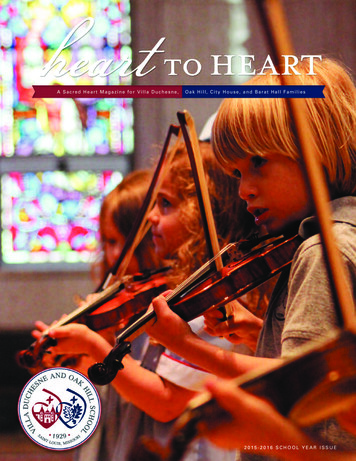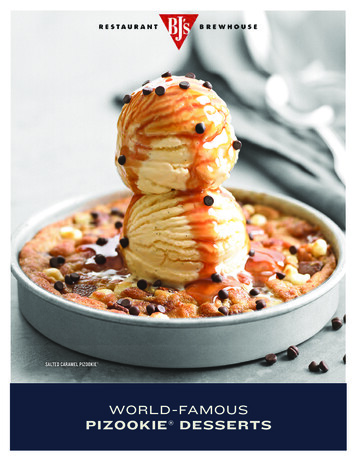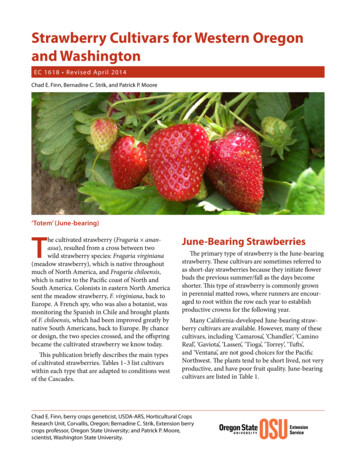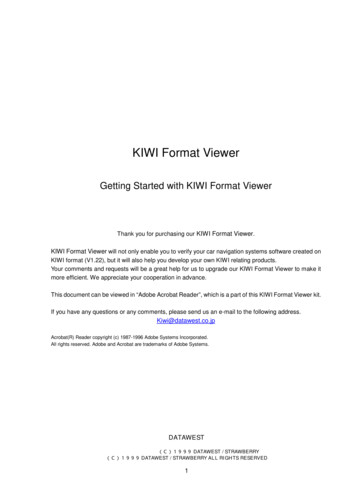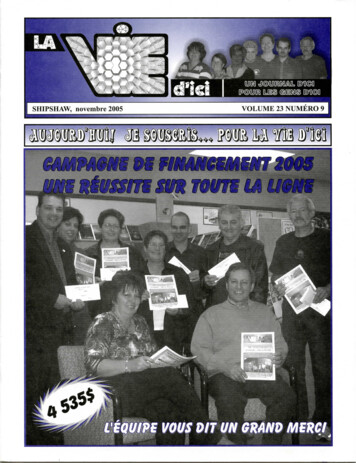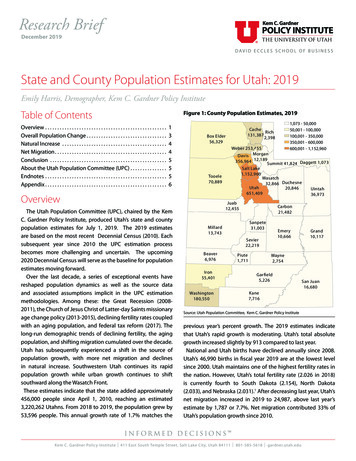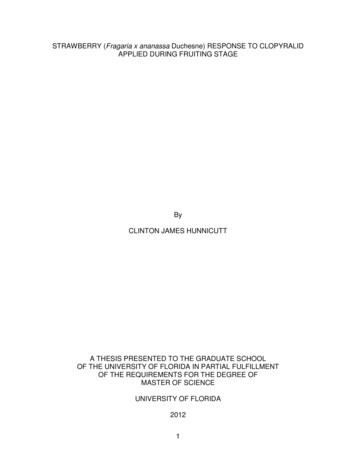
Transcription
STRAWBERRY (Fragaria x ananassa Duchesne) RESPONSE TO CLOPYRALIDAPPLIED DURING FRUITING STAGEByCLINTON JAMES HUNNICUTTA THESIS PRESENTED TO THE GRADUATE SCHOOLOF THE UNIVERSITY OF FLORIDA IN PARTIAL FULFILLMENTOF THE REQUIREMENTS FOR THE DEGREE OFMASTER OF SCIENCEUNIVERSITY OF FLORIDA20121
2012 Clinton James Hunnicutt2
To my parents3
ACKNOWLEDGMENTSI would like to thank numerous people for their help in the completion of thisproject. I would like to thank my advisor and co-advisor, Dr. Andrew MacRae and Dr.Joseph Noling for their continued support throughout this project and for teaching memany things that cannot be learned in the classroom. I will always be grateful for theopportunity you gave me to further my education at the University of Florida. Also Iwould like to thank Dr. Jason Ferrell and Dr. Peter Dittmar for serving on my committeeand always being there with advice and support throughout the project.I would also like to thank Jose Moreno, Tyler Jacoby, Cristiane Alves, and theentire GCREC farm crew for their help in establishing and maintaining these trialsthroughout the season. I would like to give a big thank you to Mihai Giurcanu from theIFAS Statistics Consulting Department for his help in the statistical analysis.Also I thank Juliann Davis for her continued support throughout this process.Finally I would like to thank my parents. Without your love and support throughout myeducation this would not have been possible. I am thankful for the person you haveraised me to be and will always be grateful for the opportunities you have madeavailable to me. Thank you to all.4
TABLE OF CONTENTSpageACKNOWLEDGMENTS . 4LIST OF TABLES . 7LIST OF FIGURES . 8LIST OF ABBREVIATIONS . 9ABSTRACT . 10CHAPTER1INTRODUCTION . 12Florida Strawberry Industry . 12Fumigation . 12Methyl Bromide . 13Methyl Bromide Alternatives . 14Strawberry Production . 15Cultivars . 15Irrigation and Fertilization . 19Mulches . 21Soil Borne Strawberry Pests . 22Diseases. 22Nematodes . 24Weeds . 25Weed Competition in Strawberry . 25Weed Control In Strawberry. 27Herbicides . 28Clopyralid . 30Clopyralid Use in Strawberry . 322GREENHOUSE GROWN STRAWBERRY RESPONSE TO A SPRAYAPPLICATION OF CLOPYRALID . 35Objectives . 35Materials and Methods. 36Results . 37New Leaf Formation . 38Leaf Malformation . 38Marketable Yield . 39Discussion . 393FIELD GROWN STRAWBERRY RESPONSE TO CLOPYRALID APPLICATION . 455
Objectives . 45Materials and Methods. 45Spray Applications . 47Drip-Injected Applications . 47Results . 50New Leaf Formation . 51Leaf Malformation . 51Marketable Yield . 52Discussion . 524CONCLUSION . 61APPENDIX: EFFICACY OF CLOPYRALID FOR THE CONTROL OF BLACKMEDIC . 65Materials and Methods. 65Results and Discussion. 66LIST OF REFERENCES . 69BIOGRAPHICAL SKETCH . 776
LIST OF TABLESTable3-1pageNumber of new leaves formed per plant for 3 strawberry cultivars in responseto 6 rates of clopyralid application, 4 weeks after treatment (WAT). . 567
LIST OF FIGURESFigurepage2-1Number of new leaves formed for 4 greenhouse grown strawberry cultivars inresponse to 5 rates of clopyralid application 5 WAT . 422-2Percentage of new leaf malformation for 4 greenhouse grown strawberrycultivars in response to 5 rates of clopyralid application 5 WAT . 432-3Marketable yield of 4 greenhouse grown strawberry cultivars in response to5 rates of clopyralid (0, 213, 426, 628, 841 g ha-1), expressed as the numberof marketable fruit per plant . 443-1Leaf malformation expressed as the percentage of new leaves malformed inresponse to 6 rates of clopyralid application, 4weeks after treatment (WAT) . 573-2Number of marketable fruit expressed as a percent of the control in responseto 6 rates of clopyralid application . 583-3Fruiting cycles of 3 strawberry cultivars following clopyralid application aseither a directed foliar spray or as a drip application to soil . 593-4Minimum and maximum air temperatures following clopyralid application in 2separate ‘Festival’ trials. . 60A-1Percent control of black medic (Medicago lupulina) with 3 application rates ofclopyralid and 3 methods of clopyralid application. 688
LIST OF ABBREVIATIONSHATHours after treatmentIFASInstitute of Food and Agricultural SciencesLDPELow-density polyethylenePHIPre-harvest intervalRHRelative humidityVIFVirtually impermeable filmWAPWeeks after plantingWATWeeks after treatment9
Abstract of Thesis Presented to the Graduate Schoolof the University of Florida in Partial Fulfillment of theRequirements for the Degree of Master of ScienceSTRAWBERRY (Fragaria x ananassa Duchesne) RESPONSE TO CLOPYRALIDAPPLIED DURING FRUITING STAGEByClinton James HunnicuttAugust 2012Chair: Andrew W. MacRaeCochair: Joseph W. NolingMajor: Horticultural ScienceIn Florida, strawberry (Fragaria x ananassa Duchesne) is considered to be one ofthe most economically important winter crops, with production occurring primarily withina 13 square mile area near Plant City, Florida. Florida is responsible for supplyingapproximately 15% of the total U.S. strawberry production. Within this15%, Floridaproduces a large percentage of the domestically-grown winter strawberry crop. In 2011approximately 4,000 ha of strawberries were planted in Florida with an estimated valueof 366 million. Florida’s ability to produce strawberries at a time when others cannot isthe main reason this crop has become economically important in the state. The Floridastrawberry industry is currently facing many challenges, one of which being the loss ofmethyl bromide use as a soil fumigant, and the many challenges that must beaddressed with the transition to a new integrated pest management approach andalternative fumigant system. Recent studies are showing that along with the newfumigant systems, separate but complementary herbicide applications throughout thegrowing season will also be a necessity for acceptable weed control. The purpose ofthe studies reported herein, were to evaluate the impacts of the herbicide clopyralid on10
the fruit production of strawberry growing in an annual plasticulture cropping system.Greenhouse and open field trials were conducted, evaluating the application of varyingrates of clopyralid either as a directed spray or drip application to well established,mature plants. Strawberry fruit size, shape, and number were evaluated to determineany loss of marketable yield due to the physiological and or phytotoxic herbicidal effectsof clopyralid. Results from these studies demonstrated that when clopyralid wasapplied at the maximum labeled rate of 213 g ha-1, less than 5% leaf malformation wasobserved and yield was estimated at approximately 104% of the non-treated control.Negative effects on plant growth and yield were observed when clopyralid applicationrates reached 628 g ha-1.11
CHAPTER 1INTRODUCTIONFlorida Strawberry IndustryDuring the winter of 2010-2011 strawberries (Fragaria x ananassa Duchesne)were planted in west central Florida on approximately 4,000 ha, with an estimated valueof 366 million (NASS-USDA 2011). On an annual basis this production accounts for alarge portion of the domestically produced winter crop, and approximately 10-15% of thetotal U.S. production. As of 2007, approximately 90% of the Florida strawberryproduction occurred within Hillsborough County, with the remainder of the cropscattered throughout west-central Florida (Census of Agriculture-USDA 2007).Advancements in breeding of short-day cultivars have given producers a unique marketadvantage; resulting in the ability of Florida producers to provide strawberries at timesno other domestic producer is able to (Jones et al. 2003). This ability enables Floridaproducers to receive premium price for strawberries, resulting in the economicimportance of the crop to the state (Santos et al. 2007a).FumigationFor over 50 years it has been repeatedly demonstrated that soil fumigation isnecessary to obtain maximum plant growth and yields in strawberry production(Chandler et al. 2001; Fort et al.1996; Johnson et al. 1962; Yuen et al. 1991). Mostfumigants are typically shank-injected either prior to or during bed formation. In additionto shank injections, drip-application (chemigation) of specially formulated fumigants hasbecome a common practice in Florida strawberry.12
Methyl BromideFor more than 50 years strawberry producers in Florida have relied heavily on apreplant soil fumigation treatment with methyl bromide to alleviate pest pressures fromweeds, nematodes, and soil borne pathogens (Chandler et al. 2001). Over 50 yearsago the first successful control of Verticillium wilt (Verticillium spp.) in strawberry wasdocumented in California with a preplant application of chloropicrin (Johnson et al.1962). This sparked a new era of research in strawberry production with rapidadvances in raised bed and field application technology, plastic mulch bed covers, andrefinement of fumigant combinations. A combination of two-thirds methyl bromide andone-third chloropicrin was found to be the most effective at controlling pests and initiallybecame the industry standard (Johnson et al. 1962). In more recent years, acombination consisting of methyl bromide and chloropicrin, in a 98:2 ratio, was the morepopular choice among Florida producers.In 1993 methyl bromide was classified as a class I ozone depleting substanceunder the provisions of an international treaty known as Montreal Protocol forsubstances that deplete the ozone. At this time, the Protocol recommended a phaseout of the use and production of methyl bromide in the U.S. and other developedcountries by the year 2010 (Honaganahalli and Seiber 1996). Subsequently the U.S.Environmental Protection Agency (EPA) acting under the Clean Air Act of 1990 initiallyset a much stricter phase out date of January 1, 2001 which was ultimately postponeduntil January 1, 2005 (Ferguson and Padula 1994; Honaganahalli and Seiber 1996;Noling et al. 2011). States have the ability to request the use of additional methylbromide under a process referred to as a Critical Use Exemption (CUE). It requires acollaboration of university researchers and grower organizations to adequately describe13
and document the need for methyl bromide where “no technically or economicallyfeasible alternative to methyl bromide is shown to exist” (Noling et al. 2011).As methyl bromide reserves diminish and prices increase, many strawberryproducers who have transitioned to alternative fumigants are now beginning to observethe shortcomings of the alternative fumigants. A recent strawberry grower surveyconducted by the University of Florida Cooperative Extension Service revealed that themajority of respondents indicated that pest problems present in their fields wereincreasing (Snodgrass et al. 2011). In general, problems were reported to be increasingfollowing use of alternative fumigants including metam potassium (Potassium Nmethyldithiocarbamate), metam sodium (Sodium N-methyldithiocarbamate) and 1,3Dichloropropene/ chloropicrin combinations commercially know as Pic-Clor 60 (39:59)and Telone C35 (63:35).Methyl Bromide AlternativesPre-plant soil fumigation has historically been an essential part of weed control inplasticulture strawberry production and has been shown to be essential to maximizeyields (Johnson et al. 1962). Extensive field research continues to evaluate methylbromide alternative fumigants and fumigant systems for their herbicidal activity. Due tothe overall lack of herbicidal activity associated with many of the alternatives, weedcontrol is deemed one of the highest pest management priorities (Noling et al. 2011).Current alternative fumigants for strawberry production include chloropicrin (Pic), 1,3dichloropropene (1,3-D), metam potassium or sodium (Metam), and newly registereddimethyl disulfide (DMDS). Pre-mix combinations of chloropicrin and 1,3-D are alsoavailable such as Telone C35 and PicClor 60 , containing 35 and 60% chloropicrinrespectively. Among these fumigants, Noling (2010) reported the greatest strawberry14
yield was obtained with applications of Telone C-35 (325 L ha-1) and PicClor 60 (336kg ha-1). Othman et al. (2010) reported yields similar to methyl bromide and chlorpicrin(57:43) at 336 kg ha-1with applications of DMDS Pic (389/111 kg ha-1). Similar to thefindings of Othman et al. (2010), Noling (2010) reported higher strawberry yields thanthat of the methyl bromide and chloropicrin standard with applications of DMDS Pic(21% V/V) at 570 L ha-1. Currently the University of Florida/IFAS recommendation for amethyl bromide and chloropicrin alternative fumigant for sting nematode infestedstrawberry fields is a pre-bed application of Telone C35 at 327 L ha-1 followed by abed-top application of napropamide and oxyfluorfen at 4.45 and 0.54 kg ha-1respectively (Noling et al. 2011).Strawberry ProductionUnlike many of the northern strawberry producing regions which utilize theperennial matted-row production system, Florida strawberries are grown in an annualplasticulture cropping system much like that of many vegetables crops. This productionsystem consists of raised beds covered with polyethylene mulch, soil fumigation, andthe use of drip tubes in the bed for irrigation (Mossler 2010). Following an appropriatefumigant aeration period, bare-root strawberry plants are typically planted from midSeptember through the end of October, depending on cultivar, in central Florida.Average strawberry yields range from approximately 7,780 to 10,750 3.6 kg flats perhectare (Maynard and Santos 2007; Santos et al. 2011).CultivarsStrawberry (Fragaria x ananassa Duchesne) is a commonly cultivated crop widelyadapted to many geographic regions ranging from the low land tropics to higher altituderegions of the world with continental climate (Darnell 2003). Fragaria. x ananassa was15
first discovered in 1766 by the French botanist Antoine Nicholas Duchesne, whodetermined that Fragaria. x ananassa was a hybrid resulting from a cross betweenFragaria chiloensis L. Mill. and Fragaria virginiana Duchesne. In comparison to othercrops of major importance, the delay in cultivation of the strawberry is thought to havestemmed from the abundance in which they were available and ease in which they werecollected from the wild (Hancock 1999).The classification of strawberry cultivars is determined by the way in which theyrespond to the length of photoperiods (Darnell 2003). Long-day, or ever bearing,cultivars will initiate flower and fruit formation under daily photoperiods of lightexceeding 12 hours. The flowering and fruiting of day-neutral cultivars is based on acycle and therefore is independent of photoperiod. In Florida, the majority of strawberrycultivars grown are short-day cultivars, also referred to as June bearing. Short-daycultivars will initiate flower formation under photoperiods typically less than 14 hours oflight (Hancock 1999; Darnell 2003). These short-day cultivars are necessary forproducers in order to be able to produce a strawberry crop during the winter, which aretimes of the year favorable for strawberry growth in Florida. The majority of thestrawberries grown in Florida are shipped as fresh fruit throughout the eastern U.S. Inaddition to the need for timely production of visually attractive and tasteful fruit,producers need varieties that provide fruit capable of withstanding the effects ofhandling and travel that come with long distance shipping (Chandler et al. 2000).‘Strawberry Festival’ is short-day cultivar released by the University of Florida in2000 and recognized by growers for its consistently firm and attractive fruit, and longshelf life (Chandler et al. 2000; Chandler 2004). Currently ‘Strawberry Festival’ is the16
most widely planted cultivar throughout the west central Florida producing region(Santos et al. 2009). ‘Strawberry Festival’ originated from a cross of the seed parent‘Rosa Linda’, and the pollen parent ‘Oso Grande’ (Chandler 2004). One of thedistinguishing characteristics of ‘Strawberry Festival’ is the abundance of runners itproduces if planted in early October. ‘Strawberry Festival’ is reportedly moderatelysusceptible to anthracnose fruit rot (C. acutatum), Colletotrichum crown rot (C.gloeosporodies), and angular leaf spot (X. fragarie), however is more resistant toBotrytis fruit rot (B. cinerea) and powdery mildew (S. macularis) in comparison to othervarieties (Chandler et al. 2000; Chandler 2004). During the 2007 and 2008 growingseasons, ‘Strawberry Festival’ was shown to yield an average of 14.05 t ha -1 (Santos etal. 2009).‘Treasure’ is a short-day cultivar released in 2000 by J&P Research. ‘Treasure’originated from a 1997 cross between ‘A3’ and ‘Oso Grande’ (Chang 2002). The majordistinguishing characteristic of ‘Treasure’ is its high yields of large and early-seasonfruit. Plants of ‘Treasure’ are typically ready for harvesting 7 weeks after planting inwest central Florida production fields. ‘Treasure’ has a high tolerance for anthracnosecrown rot (C. gloeosporodies) and is moderately tolerant to botrytis (B. cinerea) incomparison to other cultivars (Chang 2002). During the 2007 and 2008 growingseasons, ‘Treasure’ was shown to yield an average of 14 t ha -1 (Santos et al. 2009).‘Florida Radiance’ is a short-day cultivar released by the University of Florida in2009 (Chandler 2009; Chandler et al. 2009). ‘Florida Radiance’ originated from a crossbetween the seed parent ‘Winter Dawn’ and the pollen parent FL 99-35 (Chandler2009). It was developed to complement ‘Strawberry Festival’ in that ‘Florida Radiance’17
was shown to provide earlier yields while still producing larger berries later in theseason, times when the production of ‘Strawberry Festival’ was not prime (Chandler etal. 2009). ‘Florida Radiance’ has been shown to be moderately resistant to Botrytis fruitrot (B. cinerea) as well as anthracnose fruit rot (C. acutatum), however is suspectible tovarious crown rots thought to be caused by C. gloeosporioides and Phytophthora spp.(Chandler 2009; Chandler et al. 2009). During the 2007 and 2008 growing seasons,‘Florida Radiance’ reportedly yielded an average of 12.8 t ha-1 (Santos et al. 2009).‘Winterstar’ is a short-day cultivar recently released by the University of Florida in2011. Formally known as FL 05-107, ‘Winterstar’ originated from a cross between‘Florida Radiance’ and ‘Earlibrite’. Fruit size and shape is described as being betweenthat of ‘Strawberry Festival’ and ‘Florida Radiance’ with a shelf life similar to ‘StrawberryFestival’ (Whitaker et al. 2012a; Whitaker et al. 2012b). ‘Winterstar’ has been reportedas being susceptible to both anthracnose (C. acutatum) and Botrytis (B. cinerea) fruitrots (Seijo et al. 2011). ‘Winterstar’ has also been shown to be susceptible to root andcrown rots when inoculated with P. cactorum (Whitaker et al. 2012a). While yields of‘Winterstar’ have shown to be comparable to ‘Strawberry Festival’ and ‘FloridaRadiance’, ‘Winterstar’ tends to show less post-freeze yield loss in comparison to‘Strawberry Festival’ and ‘Florida Radiance’ (Whitaker et al. 2012b).‘Camino Real’ is a short-day cultivar released by the University of California in2001. ‘Camino Real’ resulted from a cross between Cal 89.230-7 and Cal 90.253-3, 2unpatented advanced selections of the University of California. ‘Camino Real’ ischaracterized by its nature to fruit over an extended period of time. The fruiting patternof ‘Camino Real’ is similar to that of ‘Camarosa’, another popular California variety.18
‘Camino Real’ is moderately susceptible to both common leaf spot (R. tulasnei) andpowdery mildew (S.macularis), however has shown resistance to Verticillium wilt (V.dahlia), and Phytophthora (P. cactorum) and Anthracnose (C. acutatum) crown rots(Shaw et al. 2002).Irrigation and FertilizationIt is estimated that drip-irrigated vegetables and strawberries in Florida, totalapproximately 24,300 ha annually (Simonne and Hochmuth 2011). In Floridaplasticulture strawberry production, irrigation is provided to strawberry plants via driptubes placed in the bed, under the polyethylene mulch. Besides supplying water to thecrop, the drip tubes offer the opportunity to deliver fertilizers, pesticides, and alsofumigants to the planting beds and or strawberry crop being grown (Simonne et al.2011). University of Florida/IFAS fertilizer recommendations include a broadcastapplication of all phosphorus and approximately 20% of the nitrogen and potassiumseason requirements prior to bed preparation. The remaining nitrogen and potassium isto be injected through the drip irrigation system at rates of 0.35 to 0.84 kg ha-1 day-1,depending on the stage of the crop (Santos et al. 2011).Overhead irrigation is also a necessity in common Florida strawberry productionpractices, including field preparation, plant establishment, and for freeze protection(Mossler 2010; Simonne et al. 2011). In Florida strawberry production fields, overheadirrigation systems are usually permanently installed on a grid with an approximate 14.5m spacing within and between rows of sprinklers. Prior to bedding they are used toprovide adequate moisture to the soil for proper bed formation and fumigant retention.Adequate soil moisture is crucial when forming beds to ensure a tight-fitting mulchapplication (Simonne and Hochmuth 2011). Overhead irrigation is also utilized during19
daylight hours for approximately 7 to 10 days after planting of bare-root transplants toaid in establishment. The intent of the overhead irrigation is to maintain moisture on thefoliage of newly set transplants in order to reduce leaf temperature and water loss byway of transpiration.Overhead irrigation in strawberry production is also extensively used for freezeprotection (Simonne et al. 2011). Since strawberries are grown as a winter crop inFlorida, the foliage, flowers, and fruit are periodically exposed to overnight temperaturesat or below freezing. Water is continuously applied to plants to establish a protectivecoating of ice. In general, overhead irrigation systems are designed to provideapproximately 0.65 cm of water per hour during freeze events. While this system at theestimated application rate can be an efficient means for freeze protection, theeffectiveness of the protection at or below approximately -2 C to -3 C, or at windspeeds above 8 km h-1, is reduced (Perry 1998; Simonne et al. 2011). The overheadapplication of water provides freeze protection mainly by the latent heat of fusion of thefreezing water. Approximately 80 calories of heat energy is released for every 1g ofwater that freezes. This heat energy helps to replace the heat lost to the environmentby the foliage, flowers, and fruit (Perry 1998). While there are many benefits ofoverhead irrigation for freeze protection, it must be managed properly to avoid applyingexcess water which could lead to water soaking fruit, cracking, and significant lossesdue to rot (Hochmuth et al. 1993). Another concern in past years has been theramifications of overhead irrigation for freeze protection after repeated freeze events.Repeated ground water pumping has been linked to increased load bearing of soil20
surfaces from ponded and infiltrating water resulting in water shortages, well problems,and sinkholes (Bengtsson 1989).MulchesPolyethylene mulches provide many benefits to plasticulture cropping systemssuch as: increased early and overall yields, reduction of fertilizer leaching, retention ofsoil moisture, reduced weed growth and needs for tillage, and improving fumigantretention and efficacy (Hochmuth et al. 1988; Lament 1993; Olson 2007). Unlike othervegetable production systems in Florida, strawberry producers generally rely on onespecific type and color of polyethylene mulch. In previous years a low densitypolyethylene (LDPE), was the mulch material of choice. However, a recent surveyshowed that the majority of respondents have opted to utilize a more fumigantimpermeable film, known as virtually impermeable film (VIF) (Snodgrass et al. 2011).With reduced rate applications of methyl bromide: chloropicrin and other alternativefumigants, the economic benefits of utilizing the VIF mulch became more apparent asthe industry moved further into the post-methyl bromide era. Studies have shown VIFmulch to have a much lower permeability to many fumigant gasses, resulting in asignificantly higher retention rate of fumigant gasses in comparison to other plastics.Longer retention of soil gasses has generally resulted in enhanced pest control efficacyof alternative fumigant systems. Enhancement for pest control has been reported forweeds, nematodes, and soil borne pathogens (Nelson et al. 2001; Noling 2002; Santoset al. 2007a). Earlier prototypes of VIF mulches were not readily accepted by growersmainly due to their limited pliability, leading to problems in mulch installation. However,VIF mulch design has greatly improved and many growers are now integrating them intotheir production practices (Olson 2007). Black is the mulch color of choice for21
strawberry producers in Florida. Black polyethylene mulch is typically used in winterand early spring because it is mor
control is deemed one of the highest pest management priorities (Noling et al. 2011). Current alternative fumigants for strawberry production include chloropicrin (Pic), 1,3-dichloropropene (1,3-D), metam potassium or sodium (Metam), and newly registered dimethyl disulfide (DMDS). Pre-mix combinations of chloropicrin and 1,3-D are also
